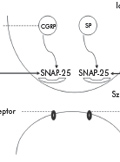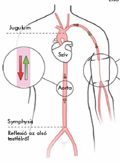The eLitMed.hu medical portal uses computer cookies for convenient operation. Detailed information can be found in the Cookie-policy.
Clinical Neuroscience - 2012;65(03-04)
Content
[Botulinum neurotoxin-A therapy in migraine]
[Although migraine is a common, paroxysmal, highly disabling disorder, the primary cause and the pathomechanism of migraine attacks are enigmatic. Experimental results suggest that activation of the trigeminovascular system is crucial in its pathogenesis. This activation leads to the release of vasoactive neuropeptides (calcitonin gene-related peptide - CGRP, and substance P - SP) and to neurogenic inflammation, and peripheral and central sensitisation are expressed. Botulinum neurotoxin-A (BoNT-A), a potent toxin produced by Clostridium botulinum, affects the nervous system through specific cleavage of the soluble NSF-attachment protein receptor complex (SNARE), like synaptosomal-associated protein of 25 kDa (SNAP-25). The result of this multistage process is blockade of the presynaptic release of pain neurotransmitters such as CGRP, SP and glutamate. A pooled analysis of the data from two programmes of Phase 3 Research Evaluating Migraine Prophylaxis Therapy (PREEMPT 1 and 2) with BoNT-A in chronic migraine demonstrated significant benefit of BoNT-A over placebo with regard to the numbers of headache days and migraine episodes. BoNT-A diminished the frequency of acute headache pain medication intake, and resulted in reductions in headache impact and improvements in scores on the Migraine-Specific Quality of Life Questionnaire. The treatments with BoNT-A proved safe and were well tolerated.]
[Fingolimod therapy in multiple sclerosis - the issue of the pathomechanism]
[Multiple sclerosis is an autoimmune inflammatory disease of the central nervous system with neurodegenerative chararacteristics. The newly discovered per os administrable drug fingolimod (FTY720) has a different mechanism of action than the current disease-modifying therapies. In vivo the drug binds to four out of the five sphingosine-1-phosphate receptors after phosphorylation. Fingolimod-phosphate (FTY720-P) causes internalization and degradation of the sphingosine-1-phosphate receptors in the membrane of lymphocytes thus in contrast to sphingosine-1-phosphate it acts like a functional antagonist. In experimental autoimmune encephalomyelitis - an animal model of multiple sclerosis - fingolimod blocks the sphingosine-1-phosphate gradient controlled lymphocyte egress from the lymph nodes and therefore reduces the peripheral lymphocyte count especially the encephalitogenic Th17 subset is reduced. Modulation of the sinus lining and blood-brainbarrier constructing endothelial cells also contributes to the complex mechanism of action. Additionally due to its liphohilic nature fingolimod is able to penetrate the blood brain barrier thus, beside its peripheral effects the drug can probably modulate the cells of the central nervous system directly. Presumably it can reduce neurodegeneration caused by astrogliosis through modification of astrocyte and oligodendrocyte activity. The results of current clinical studies are holding out with bright prospective in the aspect of either the favourable effects or the well tolerated side effects.]
[Stroke prevention - A population screening day in district XII of Budapest]
[Along with advances in the treatment of acute stroke, new efforts have been made to enhance efficiency of the prevention of cerebrovascular diseases. Population screening is a way to contact high-risk patients, and there is an increasing international and national experience with the procedure. However, efforts are associated with high costs, so an efficient method, complying with local features, should be selected from the various methods. A stroke prevention day was organized in Szent János Hospital, localized in district XII, and data were analyzed. Taking advantage of the potentials of a large hospital, a comprehensive risk assessment - within the capacity of health care workers - was performed. Program and contact information of the screening day was published in the local newspaper of the district. Data of 48 residents of the district were analyzed. In addition to neurologists, a radiologist, a cardiologist and an ophtalmologist, as well as health care workers were involved in the project. A data sheet was filled in for all participants, including known risk factors, BMI, blood pressure and serum cholesterol levels. All participants had duplex sonography of the cervical vessels, cardiac evaluation and ophtalmic examination. Data were analyzed anonymously, and - if participants approved - postcode and educational level were also recorded. Among the 48 individuals screened, 35 were female and 13 were male. Average age was 62.86 (±8.57) years, and participants were typically of higher educational level. 5 individuals had no known risk factors, most of them had 2-3 risk factors, and multiple risk factors were not uncommon. Individuals with six and seven risk factors were also found. 20 of 27 patients with known hypertension had target blood pressure levels. By duplex sonography, 36 individuals had mild, 4 had significant atherosclerosis. There was no significant carotid stenosis or occlusion. Based on ophtalmic evaluation, 26 patients had signs of vascular disease (mainly hypertensive fundus changes). Cardiac evaluation detected 14 patients with cardiovascular risk. The high standard of primary care in the district was reflected by the fact that all the 6 highrisk individuals were already taken care of by general practitioners (GP-s). One of the leading conclusions from the evaluation of the data is that local press, family ties and local communities play a major role in recruiting people for a screening day. In order to increase efficiency and cost-efficacy of the program, GP-s should also be involved in the planning process, because efficiency may be increased by pre-selecting high-risk individuals.]
[One year follow-up after stroke. A preliminary feasibility study in Josephtown of Budapest]
[Stroke is a major public health issue in Hungary with considerable regional differences in mortality. We have limited information to explain such regional differences. To assess these differences, we would need comparative followup studies optimally carried out by personal contact with the patient or the carer. According to several epidemiological studies, follow-up can be carried out with significantly lower cost and similar efficiency by telephone contact or regular mail. In this pilot study we intend to assess: 1. the efficacy of telephone follow-up one year after stroke in this geographical region 2. whether the efficacy of follow-up can be further increased with questionnaires sent out by regular mail 3. whether telephone and mail-based assessment is sufficient to perform a larger population based study. We included 135 patients hospitalized consecutively for acute cerebrovascular disease (stroke or TIA) by the Department of Neurology, Semmelweis University in January and February of 2008. Based on residence, patients were divided into three groups: those living in the least wealthy district of Budapest (i.e. District-8); those living in other districts of the city; and those living in suburban areas. One year after the hospital treatment follow-up was possible by telephone in 76%. Further 12 patients could be contacted by questionnaire sent out by regular mail. Efficacy of follow-up was altogether 84%. Even in this small group of patients, we have found a tendency for more severe strokes (p=0.06) and higher acute case fatality (32% vs. 5%, p=0.029) in residents of District-8 of Budapest compared to those residing in more wealthy districts of the city and in suburban areas. Survival rate one year after stroke or TIA was only 39% in those living in District-8, 66% in those living in other districts and 75% in suburban dwellers (p=0.006). Telephone and mail-based questionnaires are insufficient for follow-up in these regions even when applied in combination. These preliminary data raise the possibility that the socio-economical conditions might influence stroke severity and outcome in the population. A larger study to address this issue would require more accurate definition of patient-groups and more efficient follow-up methods.]
[Study of the effects of vinpocetin on cognitive functions]
[Introduction - Chronic cerebral hypoperfusion is a risk factor for the development of certain types of dementia. Mild cognitive impairment is a stage of predementia condition, because the symptoms are similar but not as severe as the symptoms in patients with dementia. Vinpocetine, due to its complex mechanism of action, has an important role in the improvement of chronic cerebral hypoperfusion. Objectives - The aim of our study was to determine the severity of the cognitive decline and to investigate the efficacy and safety of per os 18 months vinpocetine treatment in patients with mild cognitive impairment. Methods - We used psychometrical tests (MMSE, ADASCog) to assess the cognitive functions. CGIC-PGIC was used to evaluate the overall change in the disease status. ADL was used to assess the patient’s daily activity and the Hamilton Depression Scale to evaluate the patient’s mood. The assessments were performed at six visits during the 18 months treatment period. Results - At the beginning of the treatment, the stage of our patients’ mild cognitive impairment was moderately severe. Significant improvement was detected in the psychometrical tests after the 18 months treatment period. The overall status of the disease improved significantly according both to the patient and the investigator. Also significant improvement was detected in daily activity. The complex improvement of the clinical symptoms affected the patients’ mood positively. Moreover, vinpocetine was safe and had a good tolerability during the whole study period. Conclusions - Vinpocetine, due its complex mechanism of action, improved significantly the cognitive functions, overall disease status and quality of life in patients with chronic cerebral hypoperfusion. As a result, vinpocetine treatment can be recommended for patients with mild cognitive impairment.]
[The comparative analysis of arterial wall thickness and arterial wall stiffness in smoking and non-smoking students]
[Aim - Our aim was to detect the adverse effects of smoking on arterial wall thickness and arterial wall stiffness in young, healthy university students. Question - Does only a few years of smoking result in measurable vascular alterations in healthy young people? Methods - We measured the intima-media thickness (IMT) on both common carotids by means of carotid ultrasound, then we examined the stiffnessparameters of the blood vessels (pulse wave velocity, PWV; augmentation index, Aix) with the help of arteriograph. Subjects - We recruited 25 smoking and 25 non-smoking young volunteers aged 19-33 for our examinations. Exclusion citeria included any known diseases, abnormally high cholesterol levels, BMI value exceeding 30 kg/m2. Only regular smokers were allowed to participate in the smoking group (at least for six months, minimum five cigarettes a day). Results - In case of smokers morphological, hemodinamic and stiffnessparameters showed significantly higher values compared to non-smokers. Mean bilateral IMT was 0.52±0.034 mm in case of smokers, while in non-smokers we measured 0.46±0.036 mm (this difference is significant: p<0.01). PWV and heart rate also showed significantly higher values in smoking group (PWV: p<0.01; heart rate: p<0.05). Unadjusted to age, gender and smoking status there was a significant correlation between IMT and PWV (0.1 mm thicker IMT - 0.6354 m/s faster PWV). Gender differences were found in vascular changes caused by smoking. Conclusion - The adverse effects of smoking on arterial wall thickness and arterial wall stiffness can be seen even at a young age, only after a few years of smoking. Both higher IMT and higher PWV sensitively predict vascular damages.]
1.
Clinical Neuroscience
[Headache registry in Szeged: Experiences regarding to migraine patients]2.
Clinical Neuroscience
[The new target population of stroke awareness campaign: Kindergarten students ]3.
Clinical Neuroscience
Is there any difference in mortality rates of atrial fibrillation detected before or after ischemic stroke?4.
Clinical Neuroscience
Factors influencing the level of stigma in Parkinson’s disease in western Turkey5.
Clinical Neuroscience
[The effects of demographic and clinical factors on the severity of poststroke aphasia]1.
2.
3.
4.
5.















